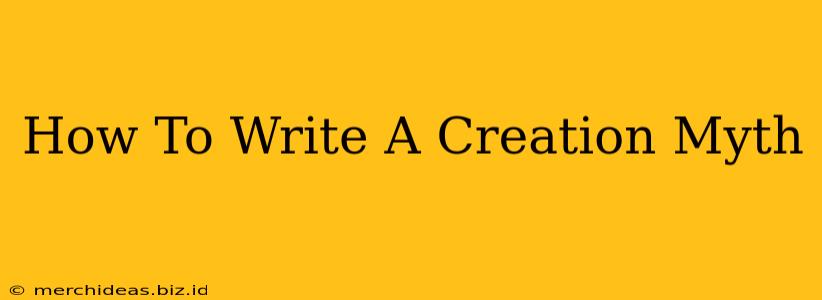Creating a myth is more than just storytelling; it's world-building, philosophy, and potent narrative all rolled into one. Creation myths, in particular, offer a unique challenge and reward: the chance to craft the very foundation of a universe. This guide will walk you through the process, offering tips and tricks to help you forge a compelling and believable creation myth, regardless of your experience level.
Understanding the Essence of Creation Myths
Before you begin writing, consider what makes a creation myth work. They're not just whimsical tales; they often serve crucial purposes for the cultures that create them:
- Explaining the Unexplainable: Creation myths address fundamental questions about existence. Why are we here? Where did everything come from? What is our purpose? Your myth should answer these questions, or at least offer a compelling perspective on them.
- Establishing Values and Beliefs: Many creation myths reflect the values and beliefs of their creators. What is good? What is evil? What are the rules of this universe? Your myth can subtly or overtly incorporate these elements.
- Providing a Sense of Order and Structure: Chaos precedes creation. Your myth should demonstrate a transition from chaos to order, establishing the laws and structures that govern your world.
- Connecting to the Natural World: Creation myths often link the natural world to the supernatural. How did mountains form? Why does the sun rise and set? Your myth can explain these phenomena through narrative.
Crafting Your Creation Myth: A Step-by-Step Approach
1. Define Your Universe's Core Principles
Begin by brainstorming the core elements of your universe. What are the fundamental forces at play? Is it a universe of magic, technology, or something else entirely? What are the dominant elements (fire, water, earth, air, etc.)? Consider:
- The Nature of Creation: Is it a singular event, a gradual process, or a cyclical phenomenon?
- The Role of Deities or Powerful Beings: Will your myth feature gods, goddesses, cosmic entities, or other powerful forces? What are their motivations, relationships, and powers?
- The Nature of Reality: What is the underlying nature of reality in your universe? Is it a single reality, or are there multiple planes of existence?
2. Develop Compelling Characters
Even in a creation myth, compelling characters can elevate the story. Whether gods, primordial beings, or even personified forces of nature, give them depth and agency. Ask yourself:
- What are their motivations? Are they benevolent, malicious, or something in between?
- What are their strengths and weaknesses?
- What are their relationships to each other? Alliances, rivalries, and love stories can add richness to your myth.
3. Structure Your Narrative
A strong narrative arc is crucial. Consider structuring your myth using a classic narrative structure:
- Inciting Incident: The catalyst that sets creation in motion.
- Rising Action: The series of events leading to the climax.
- Climax: The pivotal moment of creation.
- Falling Action: The aftermath of creation, as order emerges from chaos.
- Resolution: The state of the universe after creation is complete.
4. Embrace Symbolism and Metaphor
Creation myths are rife with symbolism. Use metaphor and symbolism to add layers of meaning to your narrative. The creation of the world could represent the birth of consciousness, the triumph of good over evil, or the cycle of life and death.
5. Refine and Revise
Once you've written your first draft, revise and refine your work. Read it aloud, seek feedback from others, and ensure your myth is coherent, engaging, and resonates with your intended meaning.
Examples of Successful Creation Myths: Inspiration and Learning
Study existing creation myths from different cultures. Analyze their structure, themes, and use of symbolism. This can provide valuable inspiration and teach you how to craft a compelling narrative. Consider exploring myths from Greek, Norse, Egyptian, and Aboriginal Australian cultures for a variety of approaches.
By following these steps and drawing inspiration from existing myths, you can craft a creation myth that is both believable and deeply resonant, leaving your readers with a renewed understanding of the universe you've created. The journey of creation is as fascinating as the result itself.
